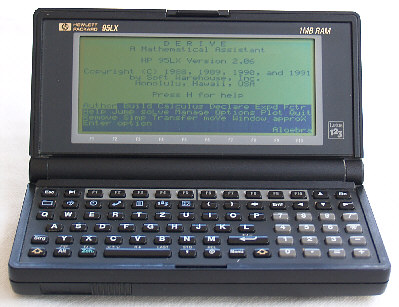DOS Palmtop: HP 95LX Details and specs
Hewlett Packard 95 LX (HP 95LX)

About this machine:
The HP 95LX was the first machine Hewlett packard produced in its series of DOS-based palmtop computers. Development codename: HP Jaguar.
While already impressive from size and handling this one was a bit ill-fated due to its main flaw - the MDA graphics (Like Atari Portfolio),
which was barely compatible with any of the available DOS applications of the time. The graphics adapter features a special "LX graphics mode"
which however no program uses besides a few handcrafted appz for the 95LX. Another very common flaw that it shares with most other DOS Palmtops
(but not with its successors 100LX and onward) is the PCMCIA 1.0 standard expansion slot which will only accept obscure SRAM memory cards -
Flash based cards can not be used. So storage is limited (SRAM cards were typically 0,5-1 MB - the largest in mine collection is 4 MB although i saw a 6 MB once). However - if you have any way of transfering files (Serial or SRAM obviously) you can load a special driver to use Flash based PCMCIA cards or CF in a PCMCIA adapter. Up to 32MB partitions maximum due to the MS-DOS version.
Another flaw it shares with all HP palmtops is the tiny keyboard which works great but is really too small compared to a standard PC keyboard.
Still it included the (back then) popular spreadsheet program Lotus 1-2-3, a basic word processor and database application, so it was still
used by some large companies and can be regarded as a mainstream product. As of 2011 the availability is high and the price is low.
It is easy to catch a HP 95LX on ebay or similar sites. As these were made in probably very large quantities and have the least practical
use due to the previously described flaws the collectible value is rather low. It's neither rare nor very useful. But at least it's not hard to
add to your collection. Hewlett packard developed the 95LX in collaboration with Lotus. The 95LX features Lotus style menus in the PIM applications.
The later 100LX model however sacrificed the lotus-style menus for more fashionable "windows style" dropdown menus.
Specs:
CPU: NEC V20 (enhanced 8088 clone), running @ 5.37 MHz
Graphics: MDA with special graphics mode (Quarter CGA resolution), 16 lines of 40 characters Text mode
Display: 240 x 128 monochrome STN , 2 scales, 4.8 inch
Memory (RAM): 512KB or 1MB (The 1 MB version was the second production run, 512KB was the first model)
ROM (Software): 1 MB
I/O ports: RS232 Serial (proprietary 4 pin cable was optional accessory), PCMCIA Type 1 slot, Infrared (SIR, NOT IrDA)
Sound: PC Speaker - Piezo
Operating System: MS-DOS 3.22
Software: Lotus 1-2-3, basic word processing, phone book, calculator, file manager
Size: Length 8.5cm, Width 15.9cm, Height 2.6cm (3.4 inches x 6.3 inches x 1 inch)
Powered by: 2 AA batteries - rechargable or non-rechargable or AC adaptor (optional accessory), CR2032 Lithium button cell as memory backup
Weight: 310 gram (11 ounces) including 2 standard AA and CR2032 batteries
Special features: LX graphics mode (Non standard MDA), SIR infrared (HP JetEye Infrared printer port compatible). RAM can be configured as additional RAMDISK space for saving user files.
Released: April 1991
Originally retailed for:: 699 USD
Clone of: Not a clone
Similar models: Later models from HP like 100LX, 200LX
Pros:
- Easily available
- Cheap to buy or replace
- Excellent for easy printing on JetEye compatible HP printers
- Contains Lotus 1-2-3 spreadsheet and word processor
- Long Battery life
Cons:
- Due to MDA barely compatible with any standard DOS application
- PCMCIA 1.0: Can only use expensive and obscure SRAM cards and very special modems
- Keyboard extremely small, not comfortable for really typing a lot
- Infrared not fully IrDA compatible
Collector Value:
1 of 10
Usage Value:
3 of 10
Verdict:
If the standard software on the ROM suits your needs you can give it a usability value of 9/10 (10/10 if you love the tiny keyboard).
Like all HP palmtops: This is as small and light as it can be and battery life is outstanding. Printing to old HP printers with the JetEye
infrared port is definitely neat. Too bad it is not fully IrDA compliant so it you will probably have a hard time communicating with anything
but a HP printer. But most users will absolutely hate the MDA graphics - you will have a hard time finding apps
that will run besides some pure MDA text-mode oldies from stone age. All later HP Palmtops feature PCMCIA Type 2 slots which enable you
to use cheap CF cards (with a PCMCIA adapter) which gives you loads of storage and a quite easy way to synchronize
data with your normal PC - so most users will find the later HP models more useful. Besides the Atari Portfolio this is probably the
most common DOS-based handheld computer available as of today so definitely not a piece you can impress fellow collectors with.
Back to the Palmtop PC index
